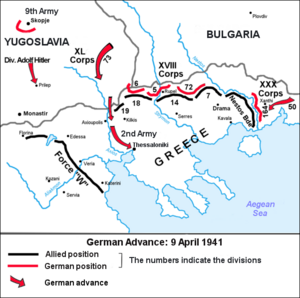Order of battle for the Battle of Greece facts for kids
On April 5, 1941, before Germany invaded Greece and Yugoslavia, different armies were ready for battle. This plan of who was where is called an "order of battle." The German invasion of mainland Greece was known as the "Battle of Greece."
Contents
German Army: Who Was Where
The German forces were led by Field Marshal Wilhelm List. His main group was the 12th Army.
Main German Groups
- 1st Panzer Group (led by General Paul Ludwig Ewald von Kleist): This group was meant to attack central Yugoslavia.
- XL Panzer Corps (led by Lieutenant General Georg Stumme): This group was positioned to attack southern Yugoslavia.
- 9th Panzer Division
- 73rd Infantry Division
- LSSAH Motorized Regiment
- XVIII Mountain Corps (led by General Franz Böhme): This group was ready to fight the Greek army along the Metaxas Line.
- 2nd Panzer Division
- 5th Mountain Division
- 6th Mountain Division
- 72nd Infantry Division
- Reinforced 125th Infantry Division
- XXX Army Corps (led by General Otto Hartmann):
- 50th Infantry Division
- 164th Infantry Division
- L Army Corps (led by General Georg Lindemann): This group was kept as a backup in Romania.
- 16th Panzer Division: This division was near the border between Bulgaria and Turkey.
The 1st Panzer Group did not play a big part in the fight for Greece. After a sudden change in Yugoslavia on March 27, their mission changed. They were sent to invade Yugoslavia and capture Zagreb instead. Their command was then given to General Maximilian von Weichs' 2nd Army.
Greek Army: Ready to Defend
The Greek Army had already been fighting against Italy since October 1940. Most of their soldiers (over 15 divisions) were still busy fighting in Albania. The forces ready to face the German attack in Macedonia were mostly new groups. They were made up of reservists and did not have many heavy weapons.
The Greek military leaders did not fully agree with the British on where to place their troops. They did not want to give up all of northern Greece. The British wanted them to defend a shorter line along the Vermion Mountains and Haliacmon River. Because of this, the Greek forces in Macedonia were split into two main groups. These groups fought separate battles.
Eastern Macedonia Army Section
This group was called the Eastern Macedonia Army Section. It was led by Lieutenant General Konstantinos Bakopoulos. They protected the strong defenses of the Metaxas Line, which stretched between Mount Beles and the Nestos river.
- 7th Infantry Division (led by Major General Christos Zoiopoulos)
- 14th Infantry Division (led by Major General Konstantinos Papakonstantinou)
- 18th Infantry Division (led by Major General Leonidas Stergiopoulos)
- 19th Mechanized Division (led by Major General Nikolaos Lioumbas)
- Nestos Brigade (led by Colonel Anastasios Kalis)
- Krousia Detachment
- Evros Brigade (led by Major General Ioannis Zisis), which was a covering force for Western Thrace
- 21 fortresses of the Metaxas Line
Central Macedonia Army Section
This group was called the Central Macedonia Army Section. It was led by Lieutenant General Ioannis Kotoulas. They were part of the 'W' Force, defending the Vermion Mountains–Haliacmon line.
- 12th Infantry Division (led by Colonel G. Karambatos)
- 20th Infantry Division (led by Major General Christos Karassos)
In total, about 65,110 Greek soldiers were ready to face the Germans. However, only about half of them were fully ready for combat.
Commonwealth Forces: The 'W' Force
The forces from the British Commonwealth were known as the "'W' Force." This name came from their commander, Lieutenant General Sir Henry Maitland Wilson.
Main Commonwealth Groups
- Australian Imperial Force (led by Lieutenant General Sir Thomas Blamey)
- 6th Australian Division (led by Major General Sir Iven Mackay)
- 2nd New Zealand Division (led by Major General Bernard Freyberg)
- British 1st Armoured Brigade (led by Brigadier Harold Vincent Spencer Charrington)
- 7th Medium Regiment, Royal Artillery
- 64th (London) Medium Regiment, Royal Artillery
- 2nd Heavy Anti-Aircraft Regiment, Royal Artillery
- 106th (Lancashire Yeomanry) Light Anti-Aircraft Regiment, Royal Artillery


